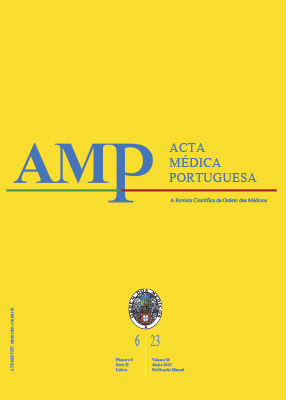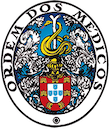Diagnóstico Pré-natal de Lisencefalia Associada a Variante Bialélica Patológica do Gene COQ2
DOI:
https://doi.org/10.20344/amp.18606Palavras-chave:
Diagnóstico Prenatal, Lisencefalia, Mutações/genética, Perturbações da Migração Neuronal, UbiquinonaResumo
A deficiência primária de CoQ10 traduz-se numa variedade de fenótipos clínicos. Todavia, não existe até à data nenhuma descrição deste défice associado a lisencefalia. A lisencefalia consiste numa alteração do desenvolvimento cortical cerebral em que se verifica um defeito na migração neuronal, detetável na neurossonografia pela persistência de um padrão de laminação cerebral após as 34 semanas de gestação e por alterações nas circunvoluções corticais. Neste trabalho descreve-se o caso de um feto masculino com um padrão de laminação cerebral alterado, detetado na avaliação ecográfica do terceiro trimestre, após exame morfológico sem alterações. A sequenciação pós-natal do exoma revelou uma variante bialélica patológica do gene COQ2, que codifica uma enzima da via da coenzima Q10 (COQ10 ou ubiquinona), envolvida na biossíntese do CoQ, um transportador redox da cadeia respiratória mitocondrial e anti-oxidante lipossolúvel. Com este caso, destaca-se a heterogeneidade fenotípica pré-natal das variantes patogénicas no gene COQ2.Downloads
Referências
Fragaki K, Chaussenot A, Benoist JF, Ait-El-Mkadem S, Bannwarth S, Rouzier C, et al. Coenzyme Q10 defects may be associated with a deficiency of Q10-independent mitochondrial respiratory chain complexes. Biol Res. 2016;49:4.
Abdelhakim AH, Dharmadhikari AV, Ragi SD, de Carvalho JR Jr, Xu CL, Thomas AL, et al. Compound heterozygous inheritance of two novel COQ2 variants results in familial coenzyme Q deficiency. Orphanet J Rare Dis. 2020;15:320.
Harel T, Hacohen N, Shaag A, Gomori M, Singer A, Elpeleg O, et al. Homozygous null variant in CRADD, encoding an adaptor protein that mediates apoptosis, is associated with lissencephaly. Am J Med Genet A. 2017;173:2539-44.
Mitani T, Punetha J, Akalin I, Pehlivan D, Dawidziuk M, Coban Akdemir Z, et al. Pathogenic variants in TUBGCP2 cause microcephaly and lissencephaly spectrum disorders. Am J Hum Genet. 2019;105:1005-15.
National Organization of Rare Diseases. Lissencephaly. [cited 2022 June 02]. Available from: https://rarediseases.org/rare-diseases/lissencephaly/.
Rakic P. Developmental and evolutionary adaptations of cortical radial glia. Cereb Cortex. 2003;13:541-9.
Pugash D, Hendson G, Dunham CP, Dewar K, Money DM, Prayer D. Sonographic assessment of normal and abnormal patterns of fetal cerebral lamination. Ultrasound Obstet Gynecol. 2012;40:642-51.
Fong KW, Ghai S, Toi A, Blaser S, Winsor EJ, Chitayat D. Prenatal ultrasound findings of lissencephaly associated with Miller-Dieker syndrome and comparison with pre- and postnatal magnetic resonance imaging. Ultrasound Obstet Gynecol. 2004;24:716-23.
Fragaki K, Chaussenot A, Benoist JF, Ait-El-Mkadem S, Bannwarth S, Rouzier C, et al. Coenzyme Q10 defects may be associated with a deficiency of Q10-independent mitochondrial respiratory chain complexes. Biol Res. 2016;49:4.
Downloads
Publicado
Como Citar
Edição
Secção
Licença
Direitos de Autor (c) 2022 Acta Médica Portuguesa

Este trabalho encontra-se publicado com a Creative Commons Atribuição-NãoComercial 4.0.
Todos os artigos publicados na AMP são de acesso aberto e cumprem os requisitos das agências de financiamento ou instituições académicas. Relativamente à utilização por terceiros a AMP rege-se pelos termos da licença Creative Commons ‘Atribuição – Uso Não-Comercial – (CC-BY-NC)’.
É da responsabilidade do autor obter permissão para reproduzir figuras, tabelas, etc., de outras publicações. Após a aceitação de um artigo, os autores serão convidados a preencher uma “Declaração de Responsabilidade Autoral e Partilha de Direitos de Autor “(http://www.actamedicaportuguesa.com/info/AMP-NormasPublicacao.pdf) e a “Declaração de Potenciais Conflitos de Interesse” (http://www.icmje.org/conflicts-of-interest) do ICMJE. Será enviado um e-mail ao autor correspondente, confirmando a receção do manuscrito.
Após a publicação, os autores ficam autorizados a disponibilizar os seus artigos em repositórios das suas instituições de origem, desde que mencionem sempre onde foram publicados e de acordo com a licença Creative Commons









